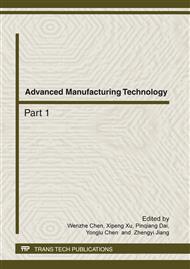p.653
p.657
p.662
p.666
p.670
p.674
p.678
p.683
p.688
FEM Simulation of Different Loading Pressures on T-Tube Hydroforming
Abstract:
The finite element simulation of T-tube hydroforming process is conducted with the FEM software Pam-Stamp 2G 2005. The results of numerical simulation and experiment are compared and analyzed. The tube hydroforming simulations under various internal pressures of constant pressure load path are also conducted. The simulation and experimental results of T-tube hydroforming are compared. The results show that the tube wall thickness distribution is more uniform and the hydroforming effect is more ideal in T-tube hydroforming process with constant pressure load path. The constant pressure load path of T-tube hydroforming is relatively easy to implement in the practical production process. Of the four constant pressure load paths of T-tube hydroforming, the simulation result under constant pressure 150MPa is most ideal.
Info:
Periodical:
Pages:
670-673
Citation:
Online since:
February 2012
Authors:
Price:
Сopyright:
© 2012 Trans Tech Publications Ltd. All Rights Reserved
Share:
Citation:


